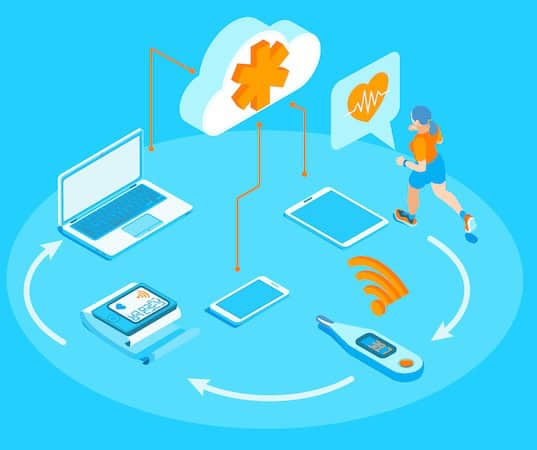Digital transformation isn’t just a buzzword in healthcare anymore. It’s the beating heart of tomorrow’s medicine. As innovation accelerates, one pillar stands paramount: the intelligent connectivity of medical devices. We’re talking about equipment that doesn’t just measure and record, but actively communicates, shares, and learns – all focused on forging an interconnected, patient-centric data ecosystem.
Digital Lifelines: Unpacking the Revolution of Medical Device Integration in Modern Healthcare
The ultimate goal? To make personalized, predictive, and proactive medicine a tangible reality, powered by high-quality, real-time data. Achieving this vision hinges on sophisticated Medical Device Software (SaMD) capable of seamlessly integrating devices, safeguarding their data, and translating raw information into actionable clinical decisions.
This article delves into the profound impact of this revolution. Exploring its mechanics, the underlying technologies, the hurdles yet to overcome, and why SaMD is rapidly becoming an indispensable component of the modern healthcare system.
The Luminary Side: Unlocking MDI’s Transformative Benefits
According to GooApps, Medical Device Integration (MDI) is far more than a technical upgrade. It’s a paradigm shift in healthcare delivery. It promises not just incremental improvements, but a fundamental reimagining of how care is delivered and experienced. Let’s illuminate the core advantages already reshaping the clinical landscape.
Real-Time Monitoring: Beyond the Beeps
Imagine a healthcare environment where delays are a relic of the past. MDI software creates a continuous, uninterrupted connection between patient sensors and their digital health record. This live feed grants healthcare professionals instant visibility into vital signs and physiological changes, enabling immediate intervention at the first sign of alteration. No more manual checks, no more information gaps – just dynamic, actionable insights.
Boosted Efficiency, Banishing Manual Burdens
One of the most significant operational advantages of MDI is the automation of clinical data recording. The era of transcribing data by hand from a device screen is drawing to a close. Integration eliminates duplicate entries, drastically accelerates workflows, and, crucially, liberates healthcare professionals from administrative drudgery. Allowing them to refocus on their core mission: providing direct, empathetic patient care.
A Unified Clinical Narrative
With all connected devices feeding into a central system, MDI constructs a comprehensive, holistic clinical profile for each patient. Whether data originates from a bedside monitor, a pulse oximeter, or a remote tracking app. Every piece of information converges in a single, accessible location. This unified view ensures the entire medical team operates from the same, complete narrative, devoid of information silos or disconnections.
Expanding Care Through Remote Monitoring
Thanks to the pervasive connectivity of medical devices and the explosive growth of digital health, remote patient monitoring (RPM) is no longer a futuristic concept. MDI makes it possible to track chronic patients, post-surgical recovery, or individuals in rural areas from virtually anywhere. Integrated systems enable medical staff to receive critical alerts and act promptly. Often mitigating the need for physical visits and expanding access to care.
Data-Driven Clinical Intelligence
MDI isn’t just about collecting data. It’s about making it intelligent. Analytical tools connected to integrated medical device software unlock profound insights into health patterns, clinical progression trends, and therapeutic efficacy. This rich data landscape paves the way for a more preventive and deeply personalized form of medicine. Moving beyond reactive treatments to proactive health management.
Personalized Care Through RPM Services
The rise of Remote Patient Monitoring (RPM) services facilitates highly individualized follow-up care through subscriptions tailored to each patient’s unique clinical profile. MDI provides the backbone for this personalized approach, enabling specific, scalable, and significantly more cost-effective monitoring plans.
Beyond clinical benefits, it breaks down geographical barriers. Reduces hospital readmissions, and empowers patients with greater control over their health journey. Leading to improved therapeutic adherence and overall well-being.

The Unseen Battlegrounds: Navigating the Complex Challenges of Medical Device Integration
The promise of a hyper-connected, data-driven healthcare system is electrifying. Medical Device Integration (MDI) stands as a cornerstone of this digital transformation. Envisioning a future where every patient’s journey is mapped in real-time, every vital sign contributes to a holistic clinical picture, and every decision is informed by immediate, precise data.
However, beneath the gleaming facade of innovation, a complex landscape of hurdles awaits. Implementing MDI is not merely a technical upgrade. It’s a profound overhaul, and like any revolution, it comes with its share of formidable challenges. Understanding these “unseen battlegrounds” is crucial for any healthcare institution striving to fully harness the power of integrated digital health.
The Digital Tower of Babel: Interoperability Amongst Manufacturers
Perhaps the most significant obstacle to seamless MDI is the fragmented world of device manufacturers. Each vendor often designs its equipment with proprietary data structures and unique communication protocols. This creates a veritable “Digital Tower of Babel”, where different devices struggle to “speak” the same language. Making integration a complex, technical friction point.
Overcoming this requires meticulous planning, deep expertise in healthcare interoperability standards (like HL7 and FHIR), and, frequently, bespoke integration work. For smaller healthcare centers without dedicated regulatory or IT staff, this can become an overwhelming technical and resource burden.
The Shifting Sands of Regulation: Keeping Pace with Compliance
The healthcare regulatory landscape is a constantly evolving entity. Software as a Medical Device (SaMD), data protection laws (suchably GDPR and HIPAA), and clinical validation requirements are perpetually in flux, both nationally and internationally. Keeping abreast of these changes, ensuring continuous compliance, and validating systems can be a relentless challenge.
This regulatory tightrope walk is particularly arduous for smaller institutions lacking the dedicated personnel or resources to navigate a legal environment that demands constant vigilance and adaptation. Non-compliance, even unintentional, carries severe penalties, making this a high-stakes arena.
The Price of Progress: Confronting High Initial Costs
While the long-term benefits of MDI are compelling, the initial investment can be substantial. Integrating medical devices isn’t just about purchasing new technology; it encompasses significant expenditures in consulting. Also staff training, rigorous testing, and ongoing support infrastructure.
Therefore, embarking on an MDI project without a crystal-clear Return on Investment (ROI) strategy is akin to sailing without a compass. A well-defined strategy must meticulously outline not only the clinical and operational gains but also the mid-term economic benefits to justify the upfront financial commitment.
The Human Element: Bridging the Digital Divide
As with any profound digital transformation, the adoption of a new MDI system doesn’t happen magically. Healthcare teams require comprehensive training, continuous support, and adequate time to adapt to new workflows and technologies. Without effective change management, resistance can fester, leading to underutilization of powerful tools or, worse, outright rejection.
Engaging staff early, demonstrating tangible benefits, and providing robust, ongoing education are paramount to fostering a culture of acceptance and ensuring the new system truly enhances, rather than hinders, clinical practice.
Fortifying the Digital Frontier: Security and Data Protection
In a hyper-connected environment, every integrated device represents a potential entry point for malicious actors. The more devices that are linked, the larger the attack surface becomes. MDI software must be architecturally “hardened” from its inception to protect sensitive clinical information against unauthorized access, sophisticated cyberattacks, and devastating data breaches.
Rigorous adherence to data protection regulations like GDPR, HIPAA, and other applicable laws is non-negotiable. Cybersecurity protocols, encryption, access controls, and regular audits are not optional extras but fundamental requirements for safeguarding patient privacy and maintaining trust.
The Road Ahead: Building Healthcare’s Connected Future
Medical device integration represents an inevitable and exciting frontier in healthcare. While challenges like interoperability, data security, and regulatory frameworks demand diligent attention, the undeniable benefits — from real-time monitoring and enhanced efficiency to personalized, data-driven insights — paint a clear picture of a more effective, patient-centric future.
As SaMD continues to evolve, its role in translating complex device data into actionable clinical intelligence will only grow. For healthcare providers, technology developers, and policymakers, embracing this revolution is not just an option, but a vital step towards securing the well-being of tomorrow’s patients.
The future of healthcare is intelligent, connected, and within our grasp.

